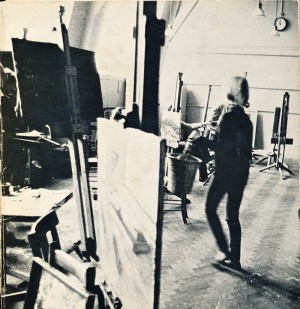‘The New Generation: 1964’ by Bryan Robertson
Curator Bryan Robertson’s essay on Hoyland, included in his first ‘New Generation’ exhibition showcasing the best of young British talent at Whitechapel Gallery.
Hoyland’s formation and subsequent development as a painter has to be placed, initially, in relation to the ‘Situation’ group. ‘Situation’ was the title of two exhibitions, in 1960 and 1961, which registered the impact on British abstract painters of certain aspects in the new American painting. First of these was the exploitation of size in order to fill the spectator’s field of vision with an environmental experience of colour. Subsequently, this became more particularized (by the time of the second, more select and more programmatic ‘Situation’ exhibition) to questions of interchangeable figure-ground relationships, of optical ambiguities within closely related tones of colour, and of the so-called ‘hard-edge’ style.
Hoyland showed in both exhibitions, without formally belonging to ‘the group’. He had left Sheffield in 1956 knowing nothing of abstract art (having been discouraged, in fact, from even indulging an interest in Rouault and Expressionism) and ended his term at the Royal Academy Schools in 1960 having been swept into the front line of abstract experiment in London. But his paintings of the ‘Situation’ period were precociously assured. Angular and linear, they consisted at first of dark, striped, close-toned fields of colour split or cut into by sharp streaks and wedges of brightness. This splintering of dark by light, of ‘soft’ by ‘sharp’, held, at the time, a special relevance for the artist. But though that particular image did not last, the paintings established a type of format which is personal and has remained with him. This is the recurrence of a figure-ground relationship (where, as in ‘Situation’ practice, figure counts as ground, and ground as figure ambivalently) in which the main field tends to be divided into two, or have two main components, which are split, or welded, or somehow activated by the line between them, whether this is in the form of horizontal wedges (as in the earlier work just mentioned) or of what is often a broad diagonal or serpentine pathway between them (as in several paintings from mid-1962 to mid-1963) or a cluster or band of forms similarly arranged (as in some of the most recent work).
Hoyland found himself in time reacting against the restrictions of ‘Situation’ practice. His main need was to get away from his own taut, compressing use of line, partly because he felt he was not working intuitively enough, partly because a predominantly linear idiom reduces most colour to areas of tone, and it was his colour he wanted most to develop. But though straight lines quickly gave away to rather slack rhythms and large, free forms, it was not till about August 1963 that he fully recovered his balance and felt able to achieve a ‘simple’ painting again in which the colour was properly dictating the form, and the forms were not ranging themselves in depth because the colour was acting like tone (that is, as contrasts of dark and light). In his new work, the expression is boldly intuitive, the configurations personal and unpredictable, the colour less romantically ominous, higher-pitched and more adventurous than anything he has achieved hitherto.
‘John Hoyland’ pp.43-44. Text from The New Generation: 1964 catalogue, Whitechapel Gallery, March-May 1964. Reproduced by permission of the Whitechapel Gallery, Whitechapel Gallery Archive
